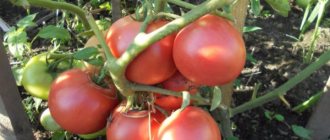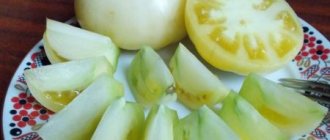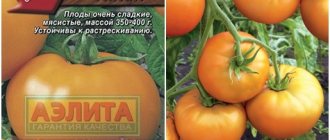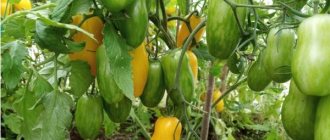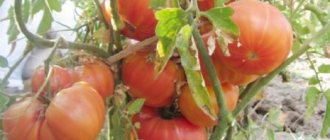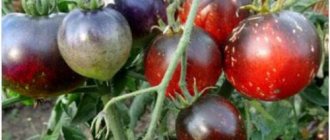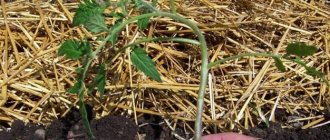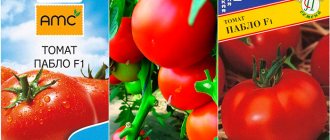Characteristics and description
Aurora is an early ripening hybrid, which is especially interesting for residents of the northwestern regions. The name of the culture personifies the ancient Roman goddess of dawn, symbolizing the early time of fruit ripening.
Distinctive features
Determinate type, height - 65-75 cm. The first cluster is tied after 6-7 leaves, the subsequent ones - every 2 leaves. The foliage is moderate, the leaves are elongated and bright green.
The ripening period is ultra-early - 90 days pass from the moment of sowing to full ripening.
The yield is high - up to 4.5 kg is harvested from 1 seedling, provided that 7-8 plants are planted per 1 square meter. m.
The hybrid is highly resistant to diseases of the nightshade family, especially late blight.
Recommended for cultivation in open ground and in greenhouse conditions. Well adapted to changes in weather conditions.
The crop does not require staking of low-growing bushes. However, vertical supports are installed next to each tomato, which the plant can do without during the period of fruit ripening.
The bushes must be pruned; the quantitative indicator of fruiting depends on this procedure. Pruning involves partial removal of unnecessary shoots.
Reference . After harvesting the first harvest, it is possible to collect ripe fruits a second time. To do this, do not remove the late side shoots that the crop throws out after the first harvest of vegetables.
Fruit characteristics
The average weight of one fruit is 110-140 g. The shape is round, the color is bright red. The taste is excellent, sweet with barely noticeable sourness. The pulp is juicy, the skin is not too dense, but is not subject to cracking.
Ripe vegetables are stored for a long time and can withstand transportation over long distances without losing their presentation. For these reasons, entrepreneurs are considering this tomato crop for commercial purposes.
The photo shows Aurora tomatoes.
Tomato variety Katya (F1)
Even tomato bushes can look very elegant and aesthetically pleasing.
One of these plants is the Katya variety, which is a racemose hybrid. It was developed by Semko-Junior LLC; the registration application was submitted relatively recently - in 2004. The variety was included in the State Register of Breeding Achievements of the Russian Federation in 2007 with permission for cultivation in the North Caucasus region (Republics of Ingushetia, Adygea, Dagestan, Kabardino-Balkarian, North Ossetia-Alania, Crimea, Chechen, Stavropol and Krasnodar territories, Rostov region) . The tomato is recommended for growing in open ground on private farms. But good growth and productivity indicators under film cover enable gardeners from cooler regions to grow this hybrid.
Description
The plant is of a determinate type, that is, not tall, which makes it easier to care for. In open ground the height is 60 - 70 cm, in closed ground - 1 meter. The stem of the variety is of medium thickness, the internodes are short. The tomato bush is not too branched, with medium foliage.
Katya's leaves are petiolate, green, of normal size and type, with a slightly corrugated surface. The inflorescence is simple, without branches. The first fruit cluster is laid over the 5th - 6th leaf, the subsequent ones are formed after 1 - 2 leaves. The brushes are well filled, each containing up to 7 - 8 ovaries.
The stalk is articulated; the place where the stalk attaches to the tomato is wide.
Katya's fruits have good density, a smooth surface, and a shape from round to flat-round. In terms of size, they can be called one-dimensional. The average weight of the fruit of the variety, according to the State Register, is 80 - 92 grams, according to the originator - the weight is from 110 to 130 grams. The skin is dense, not thick, glossy. An unripe tomato is light green, without a spot at the stalk.
When ripe it turns red. The pulp is aromatic, which is rare in hybrids, fleshy, tender. The taste is sweet and sour; gardeners note that for early tomatoes the taste is more than good. The State Register describes the taste of tomato as good and excellent. The number of seed nests is only 3 - 4 pieces.
100 grams of freshly squeezed juice contains 4.6% dry matter, 2.4% total sugar.
Characteristics
- From the appearance of the first shoots to the beginning of fruiting of the Katya hybrid, only 75 - 80 days pass, which indicates its ultra-earliness;
- According to the State Register, the yield of marketable fruits of the variety is 326 - 550 c/ha, in comparison with the Dar Zavolzhye standard this figure is 341 and 192 c/ha. The originator promises a yield in open ground of about 8 - 10.5 kg per 1 square meter, in closed ground - 13 - 15 kg per 1 square meter. meters;
- yield of marketable fruits 84 - 90%;
- The hybrid's immunity is very high. It is noted that the plant has excellent resistance to blossom end rot, late blight, tobacco mosaic virus, and Alternaria blight;
- thanks to the dense skin, the fruits are resistant to cracking;
- the harvest ripens together - this allows you to harvest the maximum number of ripe tomatoes in the first 2 harvests;
- excellent adaptability ensures that, regardless of weather conditions during the growing season, the crop will form and ripen;
- the density of tomatoes allows the crop to be transported over long distances without losing its presentation; keeping quality does not disappoint;
- The way to use the fruit is as a salad. Katya is an excellent ingredient for early salads and is also suitable for making juices.
Agricultural technology
The variety is grown in seedlings. For seedlings, tomato seeds are sown 60 - 65 days before the intended planting in a permanent place. It is best to calculate the timing yourself, as they vary somewhat depending on climatic conditions. For example, in the southern regions, seedlings can be sown from mid-February.
In cooler weather - almost a month later. Picked and hardened seedlings should be planted in open ground when the threat of spring return frosts has passed. If the weather is unstable, then use a film shelter. It is recommended to form the variety into 3 stems.
To do this, you need to leave 1 stepson under the first flower brush, and another one above it. All other stepsons need to be removed, leaving a small stump measuring 5 - 7 mm. The bushes must be tied to a support. To ensure faster ripening in the clusters, the leaves under the lower cluster are torn off.
There is an opinion among some gardeners that this variety does not need to be planted at all, but in this case the tomatoes will be smaller. Otherwise, care is no different from usual.
Pink Katya (F1)
This hybrid also belongs to Semko-Junior LLC, but for now it is new on the seed market. The year the application for registration was submitted was 2015, and in 2017 the variety was included in the State Register of Breeding Achievements of the Russian Federation with permission for cultivation in all regions of Russia. Recommended for open ground and film shelters on private farms.
How to grow seedlings
Sowing seeds for seedlings begins 2 months before planting in the ground. The seeds are first thoroughly disinfected and treated with growth stimulants.
Seed preparation
The seed is kept on the radiator for several minutes, thereby drying well. Then carefully inspect for any visible damage. Grains suitable for sowing should be light and without distortion. They are then placed in a saline solution for 10 minutes.
Seeds that float to the surface are not suitable for sowing. Next, the seed is disinfected in a weak solution of potassium permanganate for 20 minutes. After disinfection, wash in running water and dry.
To improve germination, grains are soaked in a growth stimulator for 12 hours. The swollen seeds can be sown in the ground.
Reference . Melt water can be used as a growth stimulator, in which the planting material is also placed for 12 hours.
Container and soil
The soil is prepared from a mixture of garden soil, peat and sand, taken in equal proportions. The resulting soil mixture is disinfected with a hot solution of dark potassium permanganate or calcined in the oven for 15 minutes at a temperature of 60°C. The cooled soil is laid out in planting containers, after making drainage holes to allow excess moisture to drain into them.
Reference . Peat is a necessary component for the growth and development of any crop. But in its pure form it is not suitable for growing seedlings.
Plant in a common wooden box or in individual containers: plastic cups, paper honeycombs, peat pots. Before sowing, the prepared containers are disinfected to destroy pathogenic microbes.
Sowing
Sowing the seeds is carried out to a depth of 2 cm, after slightly moistening the soil with warm, settled water. After sowing, the containers are covered with film to create a greenhouse effect and left in a bright and warm room at a temperature of at least 23°C.
Periodically remove the film for ventilation and moisten the soil as needed with warm water using a spray bottle.
Reference . Seeds are sown 3 cm apart from each other, otherwise the seedlings will stretch upward.
Seedling care
When the first shoots appear, the film is removed and the containers are moved to a more illuminated place, on the windowsill. There should be at least 14 hours of daylight. If there is a lack of natural light, add phytolamps.
Water as the top layer of soil dries out with warm, settled water using a shallow watering can along the edge of the nursery. After watering, surface loosening is carried out without touching the young roots.
When 2 true leaves appear, the seedlings dive, planting them in separate containers. If the seeds are sown in separate cups, picking is not required. When picking, only healthy and strong shoots are left, and weak ones are disposed of.
2 weeks before planting in the ground, seedlings begin to harden. The hardening procedure boils down to keeping the seedlings outside for 40-50 minutes during the daytime at a temperature of 15°C. Gradually this interval is increased to 12 hours. The night temperature in the room where the seedlings are brought is reduced to 10°C.
How to grow tomatoes
After 2 months, the seedlings are ready for transplanting. At this time, the sprouts have 6-7 true leaves and fully formed young roots.
Landing
The soil is prepared in the fall. Tomato does not like high acidity, so if the soil is highly acidic, it is neutralized with lime in the amount of 0.9 g per 1 sq. m. m. The soil is dug up and mineral fertilizers are applied.
In the spring, the soil is dug up again and organic matter and superphosphate are added. The seedlings are planted in shallow holes, at the bottom of which a little ash is first placed. After transplanting, the holes are watered, loosened and left unattended for 1 week. During this time, young bushes finally adapt to new conditions.
Reference . Tomatoes should not be planted in soil where potatoes and peppers previously grew. After these crops, the soil is greatly depleted, and tomatoes require large amounts of nutrients.
Planting pattern: 35 cm – distance between plants, 40 cm – between rows. For 1 sq. m place no more than 8 seedlings. It is best to replant after sunset or on a cloudy day.
Further care for the Aurora tomato
Regular watering is established no more than 2 times a week. Water with warm, settled water, under the root, without getting on the leaves. The best time for watering is evening or early morning. After each watering, the soil is loosened, removing all weeds with roots.
To retain moisture for a long time, the beds are mulched with straw or peat.
This method is especially important on hot and dry days , since the tomato does not like it when the top layer of soil is covered with a dried out crust.
But you can’t over-water the beds either. In this case, the risk of fungal diseases increases. The first fertilizing in the form of mineral fertilizers is applied two weeks after transplantation. A complex of mineral fertilizers can be replaced with organic matter, for example, bird droppings or mullein infusion in a ratio of 1:15. After a week, the same feeding can be repeated.
The second time the crop is fed during flowering. Add a complex of mineral fertilizers or organic matter. The need for a third feeding occurs during fruiting. In addition to organic ones, potassium fertilizers are added to the solution, which accelerate the ripening of fruits.
Advice . If the bushes initially grow poorly, you can feed them with nitrogen fertilizers. They not only stimulate plant growth, but also contribute to the growth of green mass.
Features of care and possible difficulties
Low-growing bushes do not require obligatory garter; the powerful stem is quite capable of supporting fruitful branches. But the branches themselves are spreading, and therefore vertical supports are installed under them so that when they ripen, the weight of the fruit does not bend them to the ground. Vegetables may rot if they come into contact with wet beds.
The hybrid is partially planted, removing all shoots under the lower leaves and preventing the plants from becoming dense. The hybrid shows the best quantitative indicator when formed into 1 or 2 stems.
After the first harvest, the plant produces side shoots that do not need to be removed. Soon they become fruitful branches and produce offspring a second time.
Diseases and pests
The hybrid has proven itself to be highly resistant to many diseases affecting the nightshade family. It does not suffer from late blight either. But still, we should not forget about preventive measures, which include moderate watering, systematic loosening, removal of weeds and regular ventilation of closed structures if the crop is planted in a greenhouse.
For the development of fungal spores, high humidity and high air temperatures are necessary. If the beds are not over-watered, the risk of disease is sharply reduced.
In open ground, the most dangerous insect pests are whiteflies, Colorado potato beetles, slugs and aphids.
The most important preventive measure in the fight against insects is regular inspection of bushes for the presence of pests. Prompt removal of the larvae will prevent the parasites from spreading and causing further harm.
In the fight against the Colorado potato beetle, mustard bushes planted next to the tomatoes help, as they repel the beetle with an unpleasant odor. In case of large accumulations, the drug “Prestige” is used.
A soap solution will help get rid of aphids and slugs. It is used to treat the stems and leaves of affected plants. Pheromone traps that are installed near tomatoes will save you from whiteflies. Their smell attracts the butterfly, and it flies into the trap.
Tomato care
Caring for the variety involves carrying out work related to hilling the bush, fertilizing the soil and forming the plant.
Loosening of the soil is carried out every 12-15 days. The first hilling is required after 11 days. The soil is pre-wetted. This work is necessary to ensure that new roots are formed at the bottom of the stem.
Important! Do not allow dry crust to appear around the bushes.
Watering should be done in cloudy weather or in the afternoon. The plant especially needs it when the 2nd and 3rd clusters are flowering.
12 days after planting, the first fertilization of the Aurora f1 tomato bushes with organic and mineral fertilizers is carried out. Before hilling, a second application of dry mineral fertilizers is applied. It repeats itself a week later.
Tomato bushes of the Aurora variety need staking. To do this, stakes are installed next to the stems or ropes are stretched between the rows. The first garter is carried out immediately after planting, and the next ones as needed so that the bushes do not fall.
The nuances of breeding in open and protected ground
Desirable predecessors of tomato crops are cabbage, legumes and cucumbers. After them, the earth is saturated with nitrogen, which is necessary for the life of tomatoes. You can replant a tomato in the same place after adding organic fertilizers to the soil. If the crop is planted in protected soil, the top layer of soil must be replaced and disinfected. In this way, pathogenic flora is destroyed, which significantly reduces the risk of disease.
The lower leaves of plants must be removed so that they do not come into contact with wet beds, as this can lead to the spread of fungal spores.
There is no need to thicken the plantings, otherwise the plants will prevent each other from receiving the required amount of heat and light. In addition, in such conditions, the risk of the spread of pests increases, which are difficult to detect in time.
Features of cultivation and storage
The hybrid is grown by seedling method. In the south, ultra-early hybrid tomatoes are planted using the seedless method, sowing the seeds immediately in a permanent place. This cultivation method allows you to get fruits earlier by almost a week
Tomatoes are stored well indoors, laid out for ripening in one layer in a bright place. If you need to preserve the fruits for a longer period, they are placed in boxes and kept at a temperature of +1... +3 degrees. In the cold, tomatoes can be stored for up to two months.
Advantages and disadvantages of the variety
Let's start the section review with the positive qualities of the hybrid:
- high-yielding species;
- ultra-early ripening;
- immunity to many diseases;
- good adaptation to weather conditions;
- possibility of obtaining a double harvest;
- unpretentious care;
- no mandatory garter required;
- excellent taste of fruits;
- amicable maturation;
- marketable condition;
- possibility of breeding for sale;
- long-term storage;
- long transportation;
- versatility in cooking.
The only disadvantages include planting the crop, but this procedure does not require much time and effort.
Farmer reviews
Reviews from gardeners confirm the reliability of the crop, regardless of the region of growth. Even in cold areas it will give a high yield.
Antonina, Kerch: “I was very pleased with the early maturation. There were many inflorescences and quite large. I used the fruits for canning and salads. I recommend it to everyone because I am satisfied myself. A truly unique hybrid."
Semyon, Bryansk: “This hybrid is characterized by resistance to weather conditions, so I know for sure that any cold snap will not harm it. It is very convenient to care for low-growing bushes. You can provide both root watering and thorough loosening of the soil. There are a lot of ripe vegetables, very tasty, enough for winter preparations.”
Aurora tomatoes on video
If you grew Aurora tomatoes, please write whether you liked them or not. What was the yield and taste of the fruits like under your climatic conditions? How do you rate the disease resistance of this hybrid? Briefly describe the advantages and disadvantages of this tomato in your opinion. If possible, attach a photo of your tomatoes to your comment. Thank you!
Your reviews of the Aurora tomato and additions to the description will help many gardeners evaluate this hybrid more objectively and decide whether it is worth planting or not.


